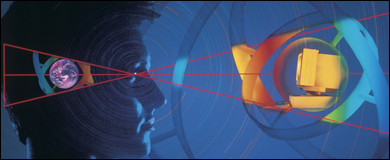Online and In Touch, Using Technology to Advance Health
 Explore CDC's new media and online tools to get credible health information when and where you choose.
Explore CDC's new media and online tools to get credible health information when and where you choose.
 CDC continues to embrace technology as an efficient and effective means to communicate with the general public, as well as with public health professionals, healthcare providers, researchers, and educators. Providing health information in various electronic formats and through multiple technologies helps CDC deliver credible health information when and where people choose.
CDC continues to embrace technology as an efficient and effective means to communicate with the general public, as well as with public health professionals, healthcare providers, researchers, and educators. Providing health information in various electronic formats and through multiple technologies helps CDC deliver credible health information when and where people choose.
In order to continue to provide credible and easily accessible information, CDC has embraced "Web 2.0" technologies that focus on engagement, online communities, collaboration, user-generated content, and innovative applications. Using these media, CDC reinforces health messages , reaches new audiences and builds a communication infrastructure based on open information exchange.
CDC's ongoing innovative ehealth communication activities include:
- Online subscription service that allows you to subscribe to updates about specific health and safety topics. There are several ways to sign up for breaking news and:
- Receive mobile text messages about health emergencies
- Receive email when new information is posted
- Receive RSS feeds updated directly to subscribers' computers
- Streaming video. In addition to new video features on CDC.gov, you can also see CDC's latest videos on the YouTube
 channel. Topics include seasonal influenza, hand washing and emergency preparedness.
channel. Topics include seasonal influenza, hand washing and emergency preparedness.  Webinars provide a cost-effective forum for training as well as conferences and presentations and CDC has increased dissemination of educational and training materials using this new communication technology
Webinars provide a cost-effective forum for training as well as conferences and presentations and CDC has increased dissemination of educational and training materials using this new communication technology - Content syndication is a technical application that allows CDC to "syndicate" certain content. CDC partners can set up mirror Web pages that repurpose CDC.gov content and are updated automatically. As an example, see the CDC page on Salmonella saintpaul and the matching University of Minnesota page.
- Photo sharing. CDC's Public Health Image Library provides access to hundreds of copyright-free public images organized by categories of people, places, and science and presented as single images, image sets, and multimedia files.
- Widgets. As small applications that you can add to your personalized homepage, blog or other Web page, widgets allow you to take pieces of CDC.gov content with you. Topics currently available as widgets include tips for everyday health, seasonal flu activity maps, public health data and statistics, and the environmental health tracking program.
- Health-e-cards are online greeting cards that allow you to email messages to encourage healthy living, promote safe activities, and celebrate health- and safety-related events. Over 100 different health-e-cards, organized into 20 health and safety categories, are currently available for you to send to your friends, family and coworkers.
 Podcasts. You can use your computer to watch or download audio and video podcasts that focus on timely health messages and public health trainings presented in an easily accessible format. Several podcast series follow a topic through several episodes for an in-depth analysis.
Podcasts. You can use your computer to watch or download audio and video podcasts that focus on timely health messages and public health trainings presented in an easily accessible format. Several podcast series follow a topic through several episodes for an in-depth analysis. - Blogs. CDC has an increased focus on leveraging the power of the blogosphere to spread health and safety messages. After learning about new science findings and public health trends from CDC, blog writers have been encouraged to spread accurate, evidence-based health messages. In a recent webinar, CDC health communication specialists and seasonal flu subject matter experts met online with mommy bloggers to discuss basic information on seasonal flu and share research on key messages that have been proven to motivate people to get vaccinated.
- ePublications, including several regularly updated, research-based online journals.
- Mobile health campaigns. Based on the growing use of mobile technologies for communication, business and entertainment, CDC has begun researching how mobile devices, such as cell phones, smart phones and health tracking devices can be used to empower people to live healthier lives. You can now access CDC's mobile-ready content by visiting http://m.cdc.gov from your mobile phone.
- Social networks. Through social networks such as MySpace
 , Caring Bridge, and DailyStrength, CDC uses this collaborative technology to reach diverse audiences and interact with interested individuals. Strategically placed health messages and resources encourage conversation around health topics and users can use CDC "badges", small online graphics with CDC health messages, on their own social network profiles to become advocates of health topics that are important to them.
, Caring Bridge, and DailyStrength, CDC uses this collaborative technology to reach diverse audiences and interact with interested individuals. Strategically placed health messages and resources encourage conversation around health topics and users can use CDC "badges", small online graphics with CDC health messages, on their own social network profiles to become advocates of health topics that are important to them.  Virtual world participation. Activities in the virtual worlds Second Life and Whyville allow users to interact with health information in a new way. Second Life residents can listen to CDC podcasts, try on a virtual biosuit, and visit the in-world lab. In Whyville, teens and grandparents can practice healthy behaviors, such as flu vaccinations and hand washing, and learn about the positive effects of healthy behaviors.
Virtual world participation. Activities in the virtual worlds Second Life and Whyville allow users to interact with health information in a new way. Second Life residents can listen to CDC podcasts, try on a virtual biosuit, and visit the in-world lab. In Whyville, teens and grandparents can practice healthy behaviors, such as flu vaccinations and hand washing, and learn about the positive effects of healthy behaviors.
Many new media and interactive technologies have become mainstream and provide innovative ways to engage users and expand reach. CDC is committed to researching and using these technologies to extend the reach and impact of public health messages and to help transform America into a healthier nation. Visit CDC Interactive Media for more information on these activities.
More Information
Current Features
Need info on a
different topic? See


